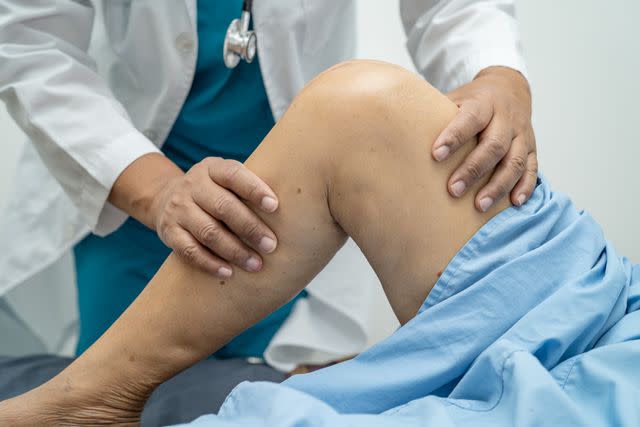What’s Causing My Knee Infection and How Do I Treat It?
Medically reviewed by Oluseun Olufade, MD
A knee infection can be caused by several different factors such as injury, surgery, or infection elsewhere in the body. An infected joint is considered an orthopedic emergency and typically requires quick and aggressive treatment to avoid potentially deadly complications.
This article will explore the symptoms and causes of a knee infection as well as how it is diagnosed and treated.

sasirin pamai / Getty Images
Knee Infection Symptoms
An infected knee joint is a serious condition that requires prompt medical management. For that reason it is important to be aware of potential symptoms. Symptoms of an infected knee joint include but are not limited to:
Swelling
Erythema or redness
Pain
Limited range of motion
Fever and/or chills
Knee Infection Causes
There are many different causes of knee infections, including injury, infection elsewhere in the body, and common bacteria.
Soft Tissue Infection
Cellulitis is an infection that starts on the skin and can spread into the deeper tissues. It usually develops after bacteria enter the body through a break in the skin or an injury. It leads to spreading warmth, redness, and pain. If left untreated, it can affect deep structures, including the joint space.
Knee Infection After Surgery
There are numerous surgical procedures that can be performed on the knee joint including total knee arthroplasty, arthroscopic surgery, and tendon repairs. One of the potential risks of any surgical procedure is the development of an infection during or after the procedure. However, this risk remains low. In total knee replacement surgery, the risk of developing an infection is around 1%.
Infection occurs when a bacterium or virus is introduced to the wound or surrounding tissue and causes an immune response. Infection after surgery is an emergency and requires immediate treatment.
Bacterial Joint Inflammation
Septic arthritis refers to an infection within the joint space. This type of infection typically starts elsewhere in the body which then spreads to the joint space via the bloodstream. Artificial joints, trauma, and preexisting conditions like rheumatoid arthritis and gout are all risk factors for developing septic arthritis. While bacteria are the most common cause, septic arthritis can also be caused by viruses or fungi.
Knee Bursitis
Bursitis occurs when bursae, fluid-filled sacs surrounding different joints, become inflamed. Bursitis can develop due to injury, trauma, repetitive motions, and other medical conditions like gout. Less commonly, bacteria can enter the bursal space and lead to infectious bursitis, which is more urgent and requires proper treatment.
Osteomyelitis
Osteomyelitis is inflammation occurring within the bone. The inflammation typically develops secondarily to an infection and can be very severe. If left untreated, osteomyelitis can potentially lead to bone necrosis, for which prompt and aggressive treatment and management are required.
Knee Infection Diagnosis
The most accurate way to determine the source of a knee infection is to aspirate, which is obtaining a sample of fluid from the joint space. Gram staining and cultures of the fluid obtained can provide important clinical information.
Certain blood tests can also be useful in diagnosing an infection, including a white blood count, sedimentation rate (ESR or sed rate), and C-reactive protein. Imaging studies such as X-ray and computed tomography (CT) scans may be beneficial in diagnosing osteomyelitis.
Knee Infection Treatment
A knee infection is a serious condition and should not be treated at home to avoid developing any dangerous complications. Typically treatment of an infected joint consists of a combination of oral or intravenous (IV) antibiotics and drainage of fluid.
Antibiotics
Once the diagnosis of an infection in the knee has been made, it is important to start IV antibiotic treatment without waiting for culture results. The antibiotic may be changed once further results determine exactly what type of organism is to blame, however, those results may take days and treatment should not be delayed.
Once IV antibiotic treatment has been completed, it is usually followed by a multi-week course of oral antibiotics to be taken at home.
Joint Drainage
Drainage of an infected joint will not only help with diagnosis, as the fluid will be sent off for analysis, but it can also help relieve symptoms as well. Drainage can either be done by the insertion of a needle into the joint space or with arthroscopic surgery. In arthroscopic surgery the fluid and affected tissue can be removed and a lavage (washing out) can be performed.
Infection After Knee Replacement Surgery
If an infection develops after a total knee replacement surgery, a two-stage revision surgery may be necessary.
When to Contact a Healthcare Provider
If a knee joint suddenly becomes red, swollen, painful, or range of motion becomes limited, it is imperative to contact a healthcare provider. While these symptoms can also be indicative of a much more benign process, a healthcare provider is the best person to determine the appropriate course of treatment. Additionally, having knee symptoms accompanied by a fever and/or chills is another reason to contact a healthcare provider.
At the end of the day an infected knee joint will most likely require quick and aggressive treatment to manage symptoms and prevent any unwanted long-term complications.
Summary
An infected knee joint can occur after surgery, trauma, superficial or deep tissue infection. It is important to be aware of the symptoms, including joint pain, redness, and limited range of motion and know when to contact a healthcare provider. Quick and aggressive treatment with IV antibiotics and drainage can help minimize the risk of serious complications such as sepsis and even death.
Read the original article on Verywell Health.

